‘Thessaloniki is Greece’s de facto ‘food city’,” says Diane Kochilas, a Greek-American TV chef with countless books on Greek and Mediterranean cuisine under her belt. The United Nations agrees, with Unesco designating Thessaloniki Greece’s first city of gastronomy in November 2021. To many, it’s no surprise to see Thessaloniki’s gastronomic culture recognised in this way: “Basically, Unesco confirmed what we have known for ages,” says local expert Chantal Jaspers of Epiculiar, a tour company that gives visitors the inside track on the city’s foodie scene.
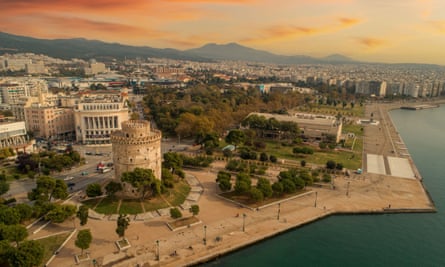
A journey through the history of this important trading port is an encounter with empires – Hellenistic, Roman, Byzantine and Ottoman – and vibrant communities, each of which has left their mark on the city’s cuisine. “Thessaloniki is also the heart of Macedonia, one of Greece’s foremost agricultural areas,” Kochilas says. Walk through the central Modiano and Kapani markets to find juicy Naoussa peaches, Halkidiki olives and bright-red Florina peppers – this rich, regional produce takes its place in Greek, Jewish, Balkan and Turkish-influenced recipes. The result? A uniquely Thessalonian culinary repertoire, best enjoyed with a generous glass of local wine.
In addition to well-loved Greek classics such as tzatziki, souvlaki and feta-topped Greek salad, make a beeline for these local specialities on your trip to Thessaloniki:
Bougatsa
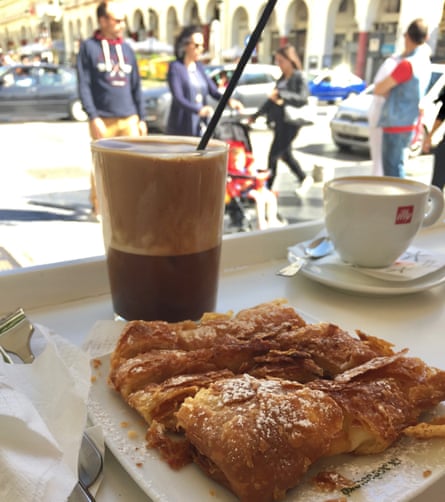
Whether you’re a cheese fiend or have a sweet tooth, bougatsa is the ultimate Thessaloniki breakfast. Now a northern Greek classic, bougatsa has its origins in Byzantine Constantinople. The layered filo pastry pie arrived in the city of Serres (about 70km from Thessaloniki) when Greeks established communities there with the population exchange after the Greek-Turkish war of 1922. “If you’ve ever walked around early in the morning, you’ve definitely caught the aroma of freshly baked bougatsa,” says Jaspers. Today, you can tuck into the most popular varieties, stuffed with feta or sweet semolina custard (doused in icing sugar and cinnamon), at traditional bougatsa joints Serraikon or Bougatsa Bantis. For a late-night sugar hit, head to Bougatsa Giannis to sample their version with Nutella-esque Merenda, or pay a visit to brunch favourite Estrella, whose “bougatsan” combines a croissant with the custard cream of a traditional bougatsa.
Soutzoukakia
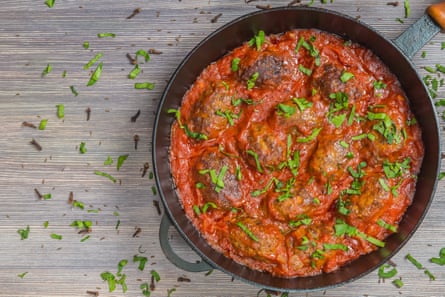
“Thessaloniki absorbed many of the Greek refugees from Asia Minor almost exactly a century ago, and their contribution to the city’s food history has been indelible,” says Kochilas. Among the most enduring of these contributions are soutzoukakia Smyrneika: oblong-shaped beef meatballs, brought from the city of Smyrna (now Izmir) by Greek refugees in 1922. Spiced with cumin, garlic and a touch of cinnamon, this comfort food is often served alongside a pile of spicy “boukovo” pepper flakes. While you’ll find soutzoukakia at many tavernas, Diavasi is hard to beat. This laid-back restaurant close to Thessaloniki’s White Tower has been grilling soutzoukakia since 1977. The key, according to chef Kostas Oustampasidis, is the “quality of the meat, and the age-old recipe” – though he’s keeping the exact formula under wraps for now. Other top spots include Diagonios and Nostos.
Koulouria
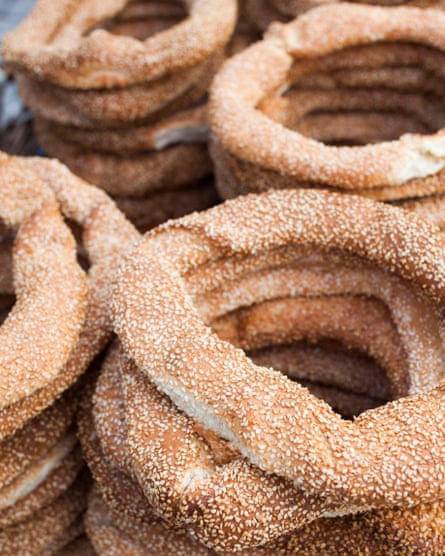
Though you’ll find sellers of these sesame-topped, bagel-esque snacks in the city’s main streets, for a more creative version of the Byzantine-era bread it’s worth seeking out one of Thessaloniki’s koulouria specialists. Pop into Mon Kulur for a koulouri filled with olive tapenade, cream cheese and turkey or a sweeter option with tahini and dark-chocolate chips worked into the dough.
Sephardic cuisine
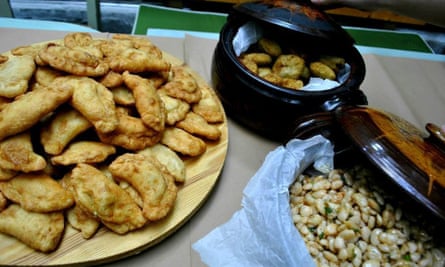
Unbeknown to many visitors, Thessaloniki was once home to Europe’s biggest Jewish community. Sephardic Jews arrived in the city following their expulsion from Spain in 1492, with their influence so significant that Thessaloniki would be nicknamed “La madre de Israel” (The mother of Israel) in the Judeo-Spanish language Ladino.
Inspired by A Taste of Sephardic Thessaloniki, a book of family recipes by Nina Benroubi (one of the city’s few Holocaust survivors), chef Kostas Markou of local restaurant Akadimia decided to introduce Sephardic dishes onto his menu. “The Sephardic cuisine is fascinating, with deep roots,” Markou says. “The ingredients used are those we also find in Greek cuisine, but the story they carry is special.” Among the dishes on offer at Akadimia, set in a former Jewish neighbourhood, are borrekitas de meredjéna, pies stuffed with aubergine; nogada, meatballs with walnut sauce; and huevos haminados, slow-cooked eggs marbled with coffee grounds. Be sure to check ahead, as Akadimia’s menu regularly changes.
Local wine

Long famed (not necessarily positively) for its penchant for retsina – white wine infused with pine resin – Greece is making a name for itself as a wine destination. In addition to international varieties, the vineyards surrounding Thessaloniki are home to native grape varieties including the white Malagousia and Assyrtiko, and red Xinomavro, Mavroudi and Limnio.
Three of Thessaloniki’s best wineries are within a 15-minute drive of each other in the countryside southwest of the city. Top of the list for local wine expert Theodore Nathanailidis, who is sommelier at hip wine bar Chilai, is Ktima Gerovassiliou. “It’s the most beautiful winery in the area, with spectacular views of the vineyards. It’s open for visitors and has a wonderful corkscrew museum!” he enthuses. He also recommends seeking out his “hidden gem wine” from the nearby Voulgari winery: “Try the Grenache Rouge. From this small, traditional vineyard we have a modern red, with plenty of red-fruit flavour.” Complete the trifecta by popping into boutique winemaker Domaine Florian for a tasting with vistas across the vines and the Thermaic gulf.
Bougiourdi
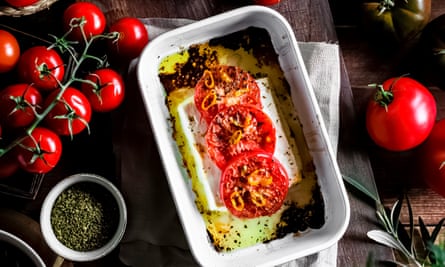
“In Thessaloniki, dishes are often just a bit more spicy than in the rest of Greece,” says Jaspers. This legacy of the 1920s arrivals is perhaps best exemplified in bougiourdi: baked feta with tomato, fresh hot peppers and chilli flakes, laced with oregano and olive oil. To fully embrace the spicy cheese theme, make sure the hot feta dip htipiti (also known as tirokafteri) forms part of your meze spread. Some of the best examples of these Thessaloniki taverna staples can be found at The Rouga, Ergon Agora and Igglis.
Trigona
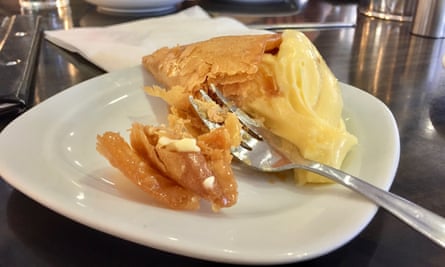
Filo once again shows itself to be king of the pastries, but this time in the form of golden, syrup-soaked cones, filled with a velvety custard. Trigona Panoramatos, to use their full title, come from the Thessaloniki suburb of Panorama, but thankfully legendary Panorama patisserie Elenidis have opened a branch in the town centre. “Thessaloniki is often called ‘sweet mother’,” says Kochilas. With a trigono in hand, it’s easy to see why.
Mussels
With the Thermaic Gulf Greece’s main mussel-producing region, it would be remiss to visit Thessaloniki without tucking into a plate or two. Move over paella: head to Ouzo Ston Pinaka to sample Thessaloniki mussel pilaf (midopilafo Thessalonikis), packed with the bold flavours of peppers, fresh onion, dill and lemon. Want to get straight to the main event? Dispense with the rice and sit down to fried mussels or mussels saganaki at colourful Bazagiazi.
Frappé
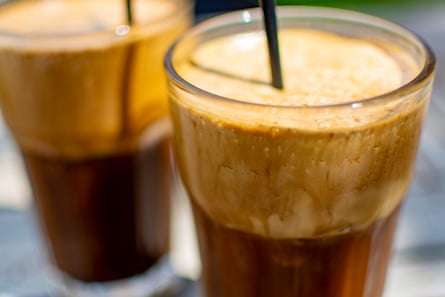
Few can turn down a frothy frappé on a hot summer’s day. The iconic iced-coffee drink was accidentally invented in 1957 at the Thessaloniki International Fair, when Nestlé representative Giannis Dritsas found himself without hot water for his usual coffee break. Instead, he put the coffee with cold water and ice in a shaker. The rest, as they say, is history, with the frappé reigning supreme until the advent of the freddo espresso and freddo cappuccino. Enjoy this piece of Thessaloniki history at one of the city’s many cafes – the most per capita of any European city, it’s said. Top coffee spots include minimalist Ypsilon and the more traditional Loux, overlooking the Roman forum.
